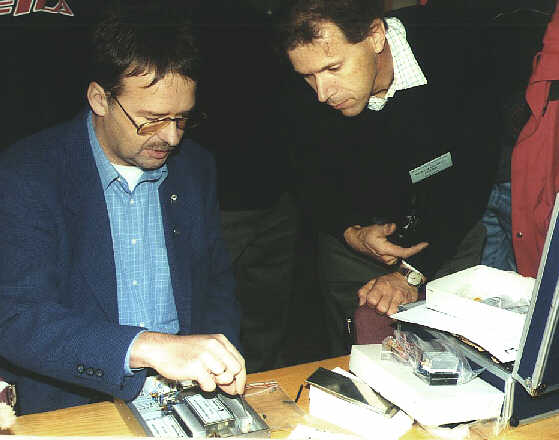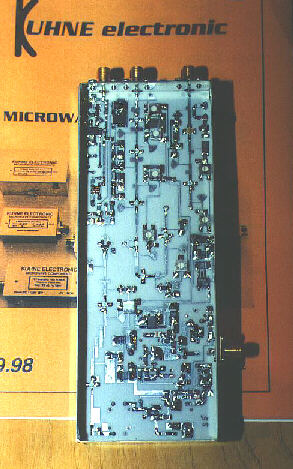

DB6NT G4ERP
Michael, DB6NT, is no stranger to microwavers for he has been producing a wide range of microwave pcbs, kits and ready-assembled modules for many years. His designs have appeared in many publications such as Dubus magazine and the Technik series of VHF/UHF/SHF compendiums.
At Martlesham he had a number of his modules on display. His latest creation is a very small, self-contained (except for a change over relay) 10GHz transverter. It measures only 150 x 55 x 30 millimetres and produces more than 200 milliwatts output on transmit and has a receive Noise Figure of 1.2dB. This makes a superb basic 10GHz transverter. All that is needed extra is a low power (3 watt) 144MHz transceiver, a 10Ghz coaxial change-over relay and a 10GHz antenna. A photograph if it appears below.
Just read the following "user" review by Dave Butler, G4ASR:
David Butler G4ASR reports that whilst recently at the Weinheim VHF meeting in Germany he purchased the latest "3rd generation" DB6NT 10GHz transverter. (Depending on the exchange rate the price of 995DM equates to approximately £360).
It measures only 30 x 55 x 150mm and is claimed to be the world's smallest
10GHz transverter. It's small size doesn't belittle its performance though.
Each unit comes with its own measured test results. David's unit produced
220mW output power (nominal 200mW min.) with a 1.3dB noise figure (1.2dB
typical). The transverter requires drive at 144MHz and has built-in i.f.
switching. Both the i.f. drive (4 watts maximum) and receiver gain (18dB)
are adjustable to suit the 2M transceiver in use.

The d.c. switch-over is also built-in, operated either automatically via a positive signal on the i.f. feed (as in the FT290) or manually via a p.t.t. to earth. Three solder pin connectors are provided for +12 to 14V d.c. power input, a 12V output (on transmit) for antenna relay and/or external p.a. and an output power monitor via a built-in directional coupler and detector. (This feature is really useful and would be a nice addition to the G3WDG amplifier kits) The Tx output and Rx input ports are SMA connectors, as is the 144MHz i.f. feed.
As a very temporary test of it's performance David decided to briefly enter the RSGB 10GHz Cumulative contest from his home QTH (IO81MX - Herefordshire) during the morning of Sunday 4 October. The transverter was placed in a biscuit tin (!) along with a G3WDG 1W p.a. The antenna changeover relay was quickly connected as was a 3-core cable for the 12V supply, 24V for the relay and p.t.t. from the 144MHz transceiver. Fortunately David already had an 18" PW dish with penny feed but no method of fixing it to the stub mast on top of the tower. As it was only a quick test, the dish was literally stuck to the 2" stub-mast by sticky brown tape! All axis were out of kilter but at least he got the polarisation correct! Once the tower was put in upright position it was visibly seen that the dish was pointing approximately 5 or moredegrees upwards. But what the heck,.... this was only a test.
Did it work? You bet it did! Without any system adjustment or antenna optimisation (just plug and play) the following stations were worked -
G4MAP/P 59 59 over a 61 kilometre path, G4ERP/P 59 59 at 64 kilometres, G3UKV/P 53 439 at 84 kilometres, G8VOI/P 53 53 at 178 kilometres and G1JRU/P 51 51 also at 178 kilometres. Not bad for a lash-up!
Interestingly David reports that the 18" dish must have been well out of focus. No specific lining up of beam heading was required other than poking the 144MHz beam in the direction of the wanted station. Every contact worked immediately without needing to re-align the dish. Indeed, signals could be heard over a 40 degree arc from all stations. Perhaps it was the Herefordshire hills or the Black Mountains causing reflections but it didn't matter. What counted was making the first 10GHz contacts from home.
The temporary system was taken down after 2-hours (it started to rain!) and is now being engineered with a proper environmental case and a 60cm off-set fed dish with elevation. So look out for more 10GHz activity in the very near future from the rare county of Herefordshire.
e-mail: david.j.butler@bt.com Telephone: 01873 860 679.
For more information on DB6NT microwave and millimetre wave kits and ready-made items click on the following link or email Michael directly to obtain his latest catalogue:
![]() RETURN TO MARTLESHAM ROUND
TABLE REPORT
RETURN TO MARTLESHAM ROUND
TABLE REPORT